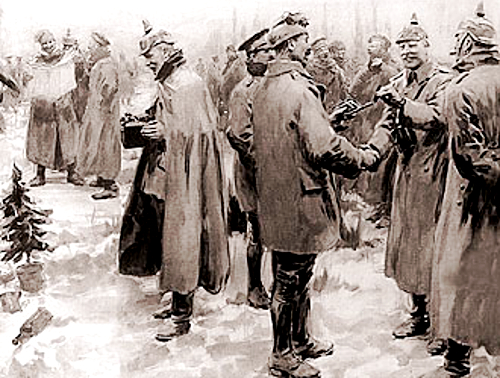This entry was originally posted March 1, 2010 at 11:50 am.
Yesterday I was reminded that I had a bunch of these “Way They Were” entries planned and had only followed through on one (Jayne and Mickey). That’s cowardly. I’m going to try to motor through more in the coming months.
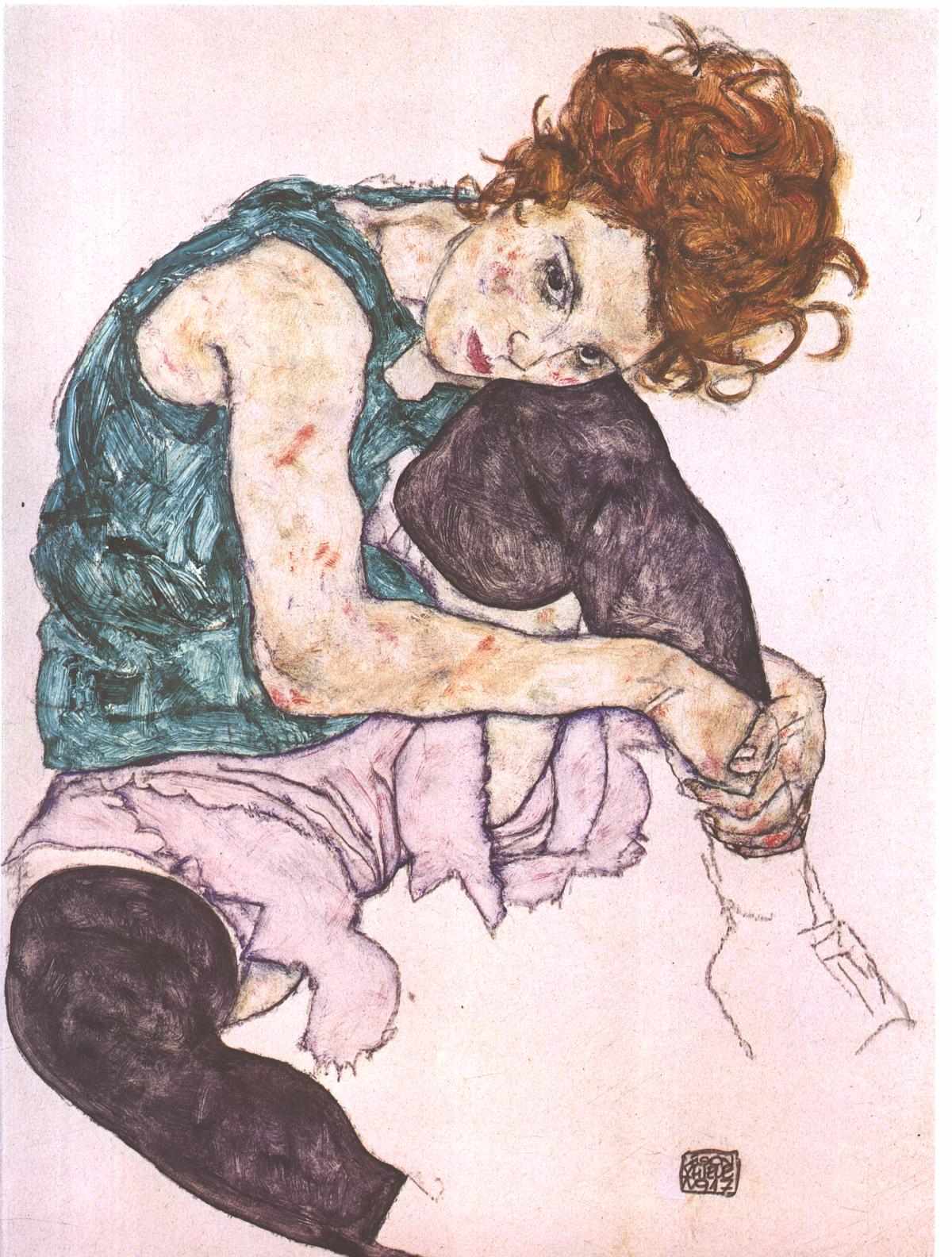
“Sitzende Frau mit hochgezogenem Knie”/”Seated woman with bent knee”, 1917.
Although artist Egon Schiele had been separated from Valerie “Wally” Neuzil and married to Edith Harms for two years by the date of this painting, most everyone agrees this is from an earlier study of Wally. It looks too much like her not to be, and he uses the colors that are associated with the Wally work. It’s my favorite work by him. It was on the cover of the Schiele book that my husband, who is a painter, had at our house in Portland, and was the entire reason I found myself opening and reading the book one day. I was interested in Schiele’s work, which is provocative and weird and has many shockingly modern features, all things I like, but, because his life was tragically cut short by disease, his career arc is brief. Coming away from the slim book about his life and art, I felt that his work was dominated by the chief feature of his life, which is to say in a nutshell his time with the real love of his life, which he royally fucked up, and it was the story of that, of Egon’s eventually jacked-beyond-repair relationship with Wally Neuzil that really sucked me in.
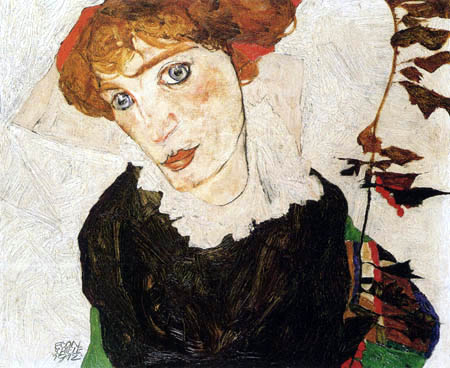
“Das Modell Wally Neuzil”/”The model Wally Neuzil.” 1912.
Artist Egon Schiele and his model, Valerie “Wally” Neuzil, were together from 1911 to 1915. He met her in Vienna when she was seventeen and he was twenty-one. Supposedly they were introduced by Gustav Klimt. Supposedly she had been Klimt’s mistress before she got together with Schiele. These things are all conjecture because everyone involved is dead, and they happened before the Great War, which so influenced the German-speaking art world in the years just following it that anything which contributed to or influenced an artist’s work before the War kind of fell by the wayside until later generations resumed their scholarship of turn of the century artists. That’s fair. Such radical changes happened during and after the War that I imagine it seemed crazy, outdated, and irrelevant to really consider too deeply the little emotional outbursts and criminal trials that came before the dramatic political events of the 1910’s and 20’s that literally reshaped the landscape.

“Rothaarige hockende Frau mit grünen Strümpfen (Valerie Neuzil)”/”Crouching figure with green stockings” (Valerie Neuzil).” 1913.
Egon and Wally left Vienna because they considered it too oppressive. They sought an inspirational, romantic, and bucolic lifestyle of freedom in the countryside, moving to Krumia — which also had the more practical benefit of much cheaper rent than Vienna — where, though Schiele’s mother was born there, they were summarily run out of town not too long after for being a little too inspirational, romantic, and bucolic: they’d been using the town’s teenagers as “models”. There’s a Schiele museum there now, so I guess that, like cream cheese, their hearts eventually softened to a spreadable cracker topping. That analogy got out of control in a hurry. It’s almost time for me to grab lunch, sorry.
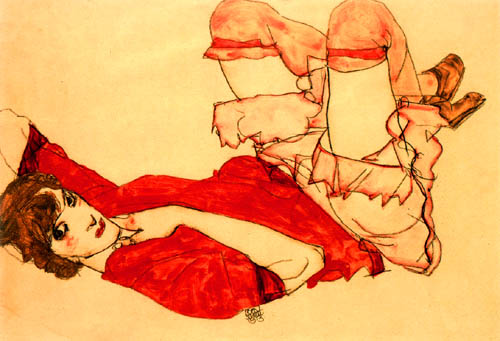
“Wally in roter Blouse mit erhobenen Knien”/”Wally in red blouse with raised knees.” 1913.
Essentially fleeing the angry mob in Krumia, Egon and Wally moved again, this time north to Nuelengbach, where it was apparently same shit, different day, as they were not there even six months and Schiele was arrested for seducing a minor. Once in custody, they dropped that charge (apparently the young lady changed her tune when the absinthe wore off?) and an abduction charge the parents had insisted be levied originally, and instead tried and found him guilty of displaying inappropriate art in a place where minors could see it. He was released from prison after serving twenty-four days in April 1912 — are you getting the idea of what an awesome prince he was? such the lucky girl, that Wally — and they moved back to the Vienna area.
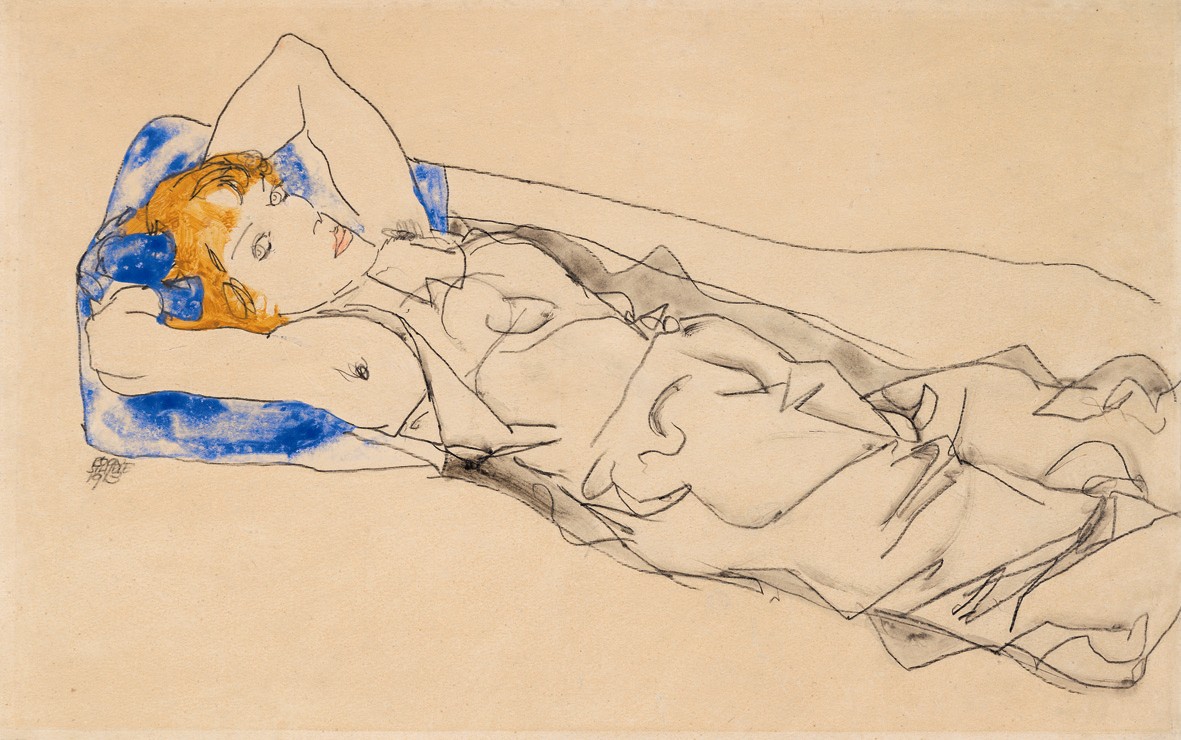
“Auf einem blauen Polster Liegende mit goldblondem Haar (Wally Neuzil)”/”Reclining female figure with gold blonde hair on a blue pillow (Wally Neuzil).” 1913.
Settled with Wally in Heitzing, a Viennese suburb, Schiele wrote to a friend in early 1915 that he was going to marry one of the Harms sisters, two locksmith’s daughters named Edith and Adele who lived across the street from his studio, for money. I guess running around for three years painting erotic pictures and pissing people off while sleeping with teenagers and doing jail time had not turned out to be the lucrative life of luxury he’d anticipated; the cash flow was getting low, and, despite that he considered Wally his partner and soulmate, marrying for money was Schiele’s timeless solution to their financial woes. He followed through on this, marrying the older of the daughters, Edith, on June 17, 1915, exactly 91 years before my own wedding day.
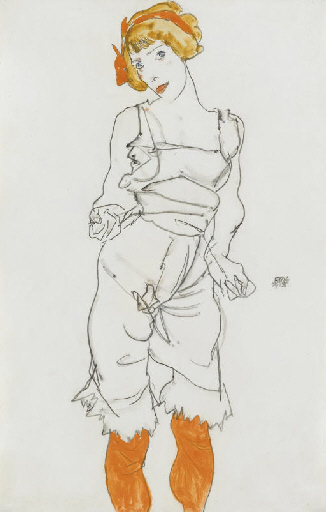
“Frau in Unterwäsche und Strümpfen (Valerie Neuzil)”/”Woman in underwear and stockings (Valerie Neuzil).” 1913.
A few days after his wedding, Schiele was called to the war, but managed to always serve in Austria, so he was able to continue with his art and stay close to his ties in Vienna. Wally had broken up with him when he told her he was getting married. Schiele wrote to friends expressing shock and grief: he’d actually expected her to understand and stay with him. He wrote a letter to Wally asking her to meet him at a billiards parlor that he liked to go to. There he gave her another letter, proposing that every year they go on an extended holiday, without his wife. She did not write back or respond positively to this. Instead, she left him and never saw him again.
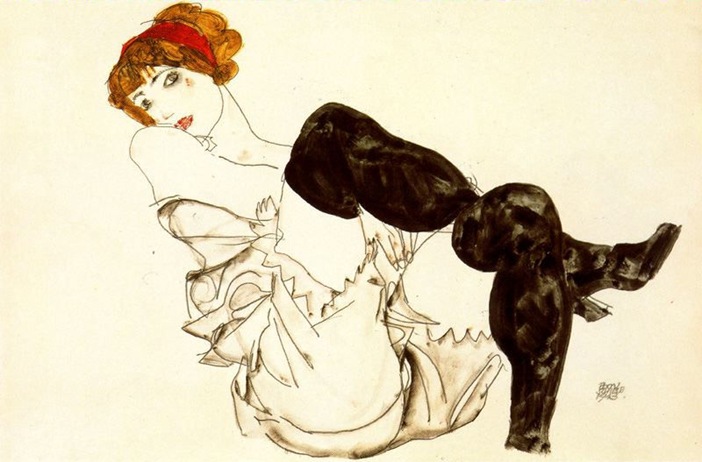
“Frau mit schwarzen Strümpfen – Valerie Neuzil”/”Woman with black stockings – Valerie Neuzel.” 1913.
I was furious when I read this. I still remember sitting in my little house in Portland and my jaw dropping, and my blood boiling, all this anger and resentment simmering in me, directed at people I never met who’d been dead nearly a century, but I couldn’t help it. I hate him for marrying someone else, I hate him and I hate the story of how they were because it reveals that through all that time they spent together, Schiele must have considered Wally lower than him, and though she stood by him , asshole though he could be, he thought her to be the unimportant one, expendable and suppressable, and he literally threw her away like garbage even though she was the best thing that had happened to him; his drawings of her are the best things he did. But that is how some stories are, and I deserve to feel angry because I need to accept that, I have to work through my sadness about the fact that nothing and no one has ever been perfect not even for a day or an hour or a moment, every joyful thing is secretly riddled through with the knowledge that this is so good now because there will be pain later and every lucky penny has a tail side of the coin, and if I have to search my soul and see if there is any gold in the dross of this love story that I in my infantile understanding of human nature found so devastating than I guess I must say that I do love that Schiele really loved Wally in an incredibly broken way, and had that time with her in which there must surely have been good moments.

Photograph of Wally and Egon from the Schiele Museum online.
Schiele died only three years after his breakup with Wally, on Halloween 1918, in an influenza epidemic which had several days earlier killed Edith and their unborn child. He passed away completely unaware that Wally Neuzil had herself succumbed to death from disease around Christmas of the previous year. She’d become a nurse for the Red Cross and, stationed at Split in Dalmatia, she caught scarlet fever from one of her patients and died in the same hospital at which she’d been working for over a year.
edit 7/6/11. Question for discussion: on a large enough timeline, aren’t we and all our petty passions and tragedies truly sound and fury, don’t we signify nothing after all? I want to think not — likely only because of vanity and childish fear of my own meaninglessness — but it seems so true.



